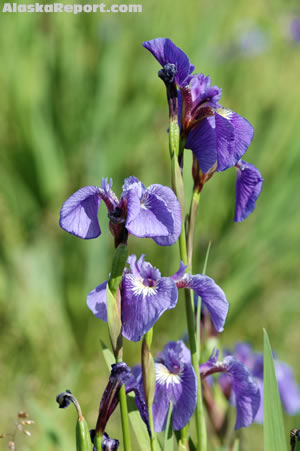
 |
|
|

Alaska Iris• From Wikipedia: The section Iris subgen. Iris sect. Oncocyclus contains the cushion or royal irises, a group of plants noted for their large, strongly marked flowers. Between 30 and 60 species are classified in this section, depending on the authority. Compared with other irises the cushion varieties are scantily furnished with narrow sickle shaped leaves and the flowers are usually borne singly on the stalks. The closely allied Iris subgenus Iris sect. Regelia, includes several garden hybrids with species in sect. Oncocyclus, known as "Regelio-cyclus" irises. They are best planted in September or October in warm sunny positions, the rhizomes being lifted the following July after the leaves have withered.Iris unguicularis (syn. I. stylosa) is a late-winter-flowering species from Algeria, with sky-blue flowers blotched with yellow, produced (in the Northern Hemisphere) from November to March or April. Japanese iris (Hanashobu, Iris ensata var. ensata, syn. I. ensata var. hortensisI. kaempferi) is extensively cultivated in Japanese gardens. Many other smaller species of bulbous iris, being liable to perish from excess of moisture, should have a well-drained bed of good but porous soil made up for them, in some sunny spot, and in winter should be protected by a covering of half-decayed leaves or fresh coco-fibre refuse. To this set belong I. milifolia, I. junonia, I. danfordiae, I. reichenbachii and others which flower as early as February and March. The cushion irises are somewhat fastidious growers, and to be successful with them they must be planted rather shallow in very gritty well-drained soil. They should not be disturbed in the autumn, and after the leaves have withered the roots should be protected from heavy rains until growth starts again naturally. Eklutna, Alaska Photo by Dennis Zaki |
|